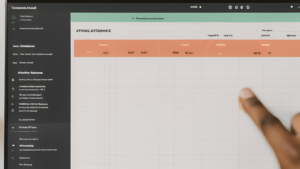Policy Development

Building a supportive work environment starts with a strong foundation. Clear and inclusive mental health policies lay the groundwork for a culture that prioritizes employee well-being. These policies should outline the company’s commitment to mental health, provide guidelines for recognizing and addressing mental health issues, and ensure confidentiality and support for affected employees. Smart mental health policies go beyond words. They empower employees with the tools they need to thrive, offering options like flexible work arrangements, reasonable accommodations, and easy access to mental health resources. It’s a win-win for both employee well-being and company success.
For example, Unilever has implemented a comprehensive mental health policy that includes mental health training for managers, employee assistance programs (EAPs), and initiatives to reduce the stigma around mental health issues. This policy has improved mental health awareness and support across the organization, demonstrating the importance of clear and actionable policies.
Training and Education

Training and education are crucial for raising awareness and equipping employees and management with the skills needed to support mental health. Training programs should focus on identifying signs of mental health issues, providing appropriate support, and promoting a culture of understanding and empathy. Leaders are the lighthouse, guiding the way. Investing in management training on mental health is crucial. Equipped leaders can create a ripple effect, fostering a supportive culture and empowering teams to prioritize well-being.
Regular, ongoing education ensures that mental health remains a priority and that all employees are informed about available resources and support mechanisms. Companies like PwC offer mental health first aid training to their employees, teaching them how to respond to mental health crises and support their colleagues effectively. This continuous education fosters a knowledgeable and supportive workforce.
Creating Open Communication Channels

Silence is the enemy of well-being. Building a truly supportive environment hinges on open communication. When employees feel safe talking about their mental health, the walls of stigma crumble, paving the way for a culture of care and support. Tools and methods for fostering open communication include regular check-ins, anonymous feedback channels, and mental health forums or support groups.
Vulnerability is the new strength. When leaders and employees step up and share their mental health journeys, it breaks the ice. These open conversations normalize mental health struggles, creating a safe space for everyone to seek and offer support. For instance, Bell Canada’s “Let’s Talk” initiative encourages employees to speak openly about mental health, significantly reducing stigma and promoting a supportive workplace culture. Effective communication channels ensure employees feel heard and supported, which is crucial for their mental well-being.
Providing Resources and Support

Providing accessible mental health resources and support is essential for a supportive work environment. Resources, counseling services, mental health days, and wellness programs offer crucial support for employees facing mental health challenges. It is important to ensure these resources are easily accessible and employees are encouraged to use them.
Promoting these resources through regular communication, workshops, and mental health awareness campaigns can help increase their utilization. For example, Deloitte offers a comprehensive EAP that includes counseling services, stress management workshops, and access to mental health professionals. Don’t let resources gather dust! Having great mental health resources is just the first step. Making sure they’re well-promoted, easily accessible, and free of stigma is crucial. Employees won’t benefit from what they don’t know exists, so let’s bridge that gap and unlock the power of well-being support.
Building a mentally healthy workplace isn’t a one-time project, it’s an orchestra with many instruments. Inclusive policies are the sheet music, ongoing training refines the skills, open communication creates harmony, and accessible resources are the instruments themselves. By playing all these parts together, we can create a beautiful symphony of employee well-being. These strategies collectively contribute to a healthier, more productive, and engaged workforce, ultimately benefiting employees and the organization.




 Just like a well-oiled machine, employee success hinges on strong mental well-being. When their minds are healthy, they can thrive both on and off the job. In the workplace, mental health affects how individuals think, feel, and act, influencing their ability to handle stress, relate to colleagues, and make decisions. When mental health issues such as stress, anxiety, or depression are prevalent, they can lead to decreased productivity, higher absenteeism, and increased turnover rates. Flip the switch on employee performance! Fostering a culture of mental well-being leads to a surge in engagement, motivation, and productivity.
Just like a well-oiled machine, employee success hinges on strong mental well-being. When their minds are healthy, they can thrive both on and off the job. In the workplace, mental health affects how individuals think, feel, and act, influencing their ability to handle stress, relate to colleagues, and make decisions. When mental health issues such as stress, anxiety, or depression are prevalent, they can lead to decreased productivity, higher absenteeism, and increased turnover rates. Flip the switch on employee performance! Fostering a culture of mental well-being leads to a surge in engagement, motivation, and productivity. Moreover, addressing mental health proactively can lead to substantial economic benefits. A healthier workforce translates to a stronger bottom line. Fewer sick days, lower healthcare burdens, and increased productivity all contribute to the company’s financial well-being. Companies investing in mental health initiatives can expect a return on investment through a more resilient and capable workforce. Therefore, fostering a supportive mental health environment is essential for employee well-being and organizational success.
Moreover, addressing mental health proactively can lead to substantial economic benefits. A healthier workforce translates to a stronger bottom line. Fewer sick days, lower healthcare burdens, and increased productivity all contribute to the company’s financial well-being. Companies investing in mental health initiatives can expect a return on investment through a more resilient and capable workforce. Therefore, fostering a supportive mental health environment is essential for employee well-being and organizational success. Work isn’t just about building a wall, it’s about having strong foundations. Mental health is the bedrock that supports employee performance. A healthy mind fosters focus, resilience, and the ability to tackle challenges effectively. It includes emotional, psychological, and social well-being, impacting how employees think, feel, and behave. In this context, key aspects of mental health include managing stress, maintaining work-life balance, and fostering a positive work environment.
Work isn’t just about building a wall, it’s about having strong foundations. Mental health is the bedrock that supports employee performance. A healthy mind fosters focus, resilience, and the ability to tackle challenges effectively. It includes emotional, psychological, and social well-being, impacting how employees think, feel, and behave. In this context, key aspects of mental health include managing stress, maintaining work-life balance, and fostering a positive work environment. Recognizing these issues and their impact on employees’ well-being and productivity is crucial for creating a supportive work environment.
Recognizing these issues and their impact on employees’ well-being and productivity is crucial for creating a supportive work environment. Imagine a workforce where stress casts a long shadow, sapping productivity by a trillion dollars globally each year [reference WHO statistic]. In the US alone, millions bring their mental health battles to work every day [reference NIMH statistic]. It’s clear: mental well-being is no longer a personal concern, it’s a pressing business issue.
Imagine a workforce where stress casts a long shadow, sapping productivity by a trillion dollars globally each year [reference WHO statistic]. In the US alone, millions bring their mental health battles to work every day [reference NIMH statistic]. It’s clear: mental well-being is no longer a personal concern, it’s a pressing business issue. Mental health in the workplace isn’t a one-time fix, it’s a continuous conversation. We need to keep our finger on the pulse of employee well-being, staying informed about current trends and the range of challenges they face. This awareness is the foundation for creating a supportive environment that promotes the well-being and productivity of all employees.
Mental health in the workplace isn’t a one-time fix, it’s a continuous conversation. We need to keep our finger on the pulse of employee well-being, staying informed about current trends and the range of challenges they face. This awareness is the foundation for creating a supportive environment that promotes the well-being and productivity of all employees.













 In conclusion, leadership’s role in promoting mental health is multifaceted and crucial. By leading by example, fostering an inclusive culture, and effectively recognizing and addressing burnout, leaders can significantly improve their employees’ mental health and overall well-being.
In conclusion, leadership’s role in promoting mental health is multifaceted and crucial. By leading by example, fostering an inclusive culture, and effectively recognizing and addressing burnout, leaders can significantly improve their employees’ mental health and overall well-being. We can’t improve what we don’t measure! Setting clear and measurable goals for mental health initiatives is like having a roadmap. It allows us to track progress, see what’s working, and continuously refine our efforts to cultivate a thriving workplace for everyone’s well-being. These goals provide a framework for assessing progress and identifying areas for improvement.
We can’t improve what we don’t measure! Setting clear and measurable goals for mental health initiatives is like having a roadmap. It allows us to track progress, see what’s working, and continuously refine our efforts to cultivate a thriving workplace for everyone’s well-being. These goals provide a framework for assessing progress and identifying areas for improvement. 






 Using assessment data to refine and improve mental health initiatives is crucial for their long-term success. Organizations should adopt a data-driven approach to make informed decisions about their mental health strategies. This involves:
Using assessment data to refine and improve mental health initiatives is crucial for their long-term success. Organizations should adopt a data-driven approach to make informed decisions about their mental health strategies. This involves: In conclusion, measuring the impact of mental health initiatives involves setting clear goals, conducting regular assessments, and using data to make informed adjustments. This approach ensures that mental health programs are effective, responsive, and continuously improving, ultimately fostering a healthier, more productive workplace.
In conclusion, measuring the impact of mental health initiatives involves setting clear goals, conducting regular assessments, and using data to make informed adjustments. This approach ensures that mental health programs are effective, responsive, and continuously improving, ultimately fostering a healthier, more productive workplace.




